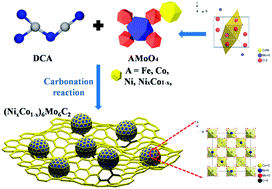Ultrafine multi-metallic carbide nanocrystals encased in a carbon matrix as durable electrocatalysts towards effective alkaline hydrogen evolution reaction†
Abstract
Durable electrolytic hydrogen production at high-current densities (>500 mA cm−2) is required as the basis of industrial scale hydrogen evolution reaction (HER). Electrocatalysts, with the purpose of accelerating HER, however, are far from meeting the requirements of high activity, cost effectiveness, and long-term stability, especially in alkaline media. Herein, a series of ultrafine bi- or tri-metallic Mo-based carbides embedded in a graphitic carbon matrix are synthesized by a direct solid reaction between metal molybdate and dicyandiamide (DCA). The components of the proposed multi-metallic carbides can be controlled in a facile manner by precisely configuring the molybdates with different metal cations, enabling the design of electrocatalysts with optimized active sites for HER. With the carbon layer protecting against corrosion, the as-prepared series of (NixCo1−x)6Mo6C2 carbides presents effective HER performance, in which the optimized stoichiometric sample ((Ni0.2Co0.8)6Mo6C2) requires an overpotential of 100 mV to drive 10 mA cm−2 current density for HER. With this electrocatalyst, a durable current density of 1000 mA cm−2 can be achieved by applying an overpotential of 1.84 V towards HER, which is even lower than the required potential of the Pt/C commercial electrocatalyst (2.12 V) for the same current density.



 Please wait while we load your content...
Please wait while we load your content...